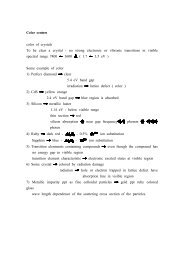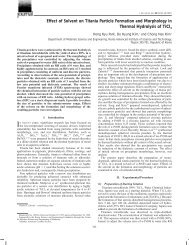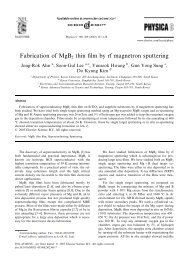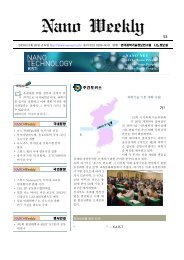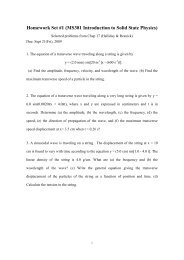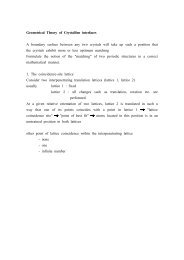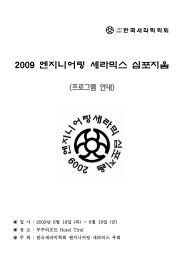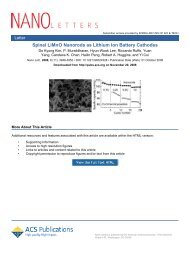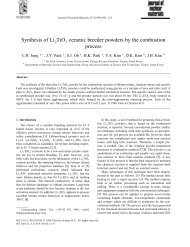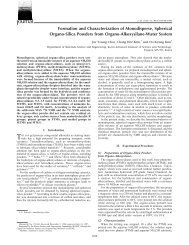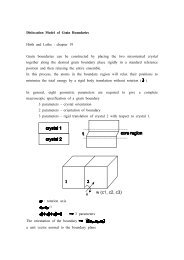Hydrothermal Synthesis of Spherical Perovskite Oxide Powders
Hydrothermal Synthesis of Spherical Perovskite Oxide Powders
Hydrothermal Synthesis of Spherical Perovskite Oxide Powders
You also want an ePaper? Increase the reach of your titles
YUMPU automatically turns print PDFs into web optimized ePapers that Google loves.
Journal<br />
<strong>Hydrothermal</strong> <strong>Synthesis</strong> <strong>of</strong> <strong>Spherical</strong> <strong>Perovskite</strong> <strong>Oxide</strong> <strong>Powders</strong> Using<br />
<strong>Spherical</strong> Gel <strong>Powders</strong><br />
Jae Young Choi, Chong Hee Kim,* and Do Kyung Kim*<br />
Department <strong>of</strong> Materials Science and Engineering, Korea Advanced Institute <strong>of</strong> Science and Technology,<br />
Taejeon 305-701, Korea<br />
<strong>Spherical</strong> perovskite oxide powders, composed <strong>of</strong> fine particulates,<br />
were prepared by using spherical gel powders<br />
under hydrothermal conditions. <strong>Spherical</strong> PbTiO 3, Ba-<br />
TiO 3, and SrTiO 3 powders were synthesized from spherical<br />
TiO 2 gel powders, and spherical PbZrO 3 powder from<br />
spherical ZrO 2 gel powder. <strong>Spherical</strong> Pb(Zr 0.5,Ti 0.5)O 3 and<br />
Ba(Zr 0.5,Ti 0.5)O 3 powders were prepared from spherical<br />
ZrTiO 4 gel powders. Lead acetate trihydrate, barium hydroxide<br />
octahydrate, and strontium hydroxide octahydrate<br />
were used as the sources <strong>of</strong> A-site ions in each perovskite<br />
oxide (ABO 3). The spherical TiO 2 and ZrO 2 gel powders<br />
were prepared by thermal hydrolysis <strong>of</strong> titanium tetrachloride<br />
and zirconium oxychloride, respectively, and spherical<br />
ZrTiO 4 gel powder by thermal hydrolysis <strong>of</strong> a mixture <strong>of</strong><br />
them in alcohol–water mixed solvent. During the hydrothermal<br />
treatment, the spherical gel powders retained their<br />
spherical shape to produce spherical perovskite oxide powders,<br />
composed <strong>of</strong> nanometer-sized particulates.<br />
I. Introduction<br />
HYDROTHERMAL powder synthesis has been known as a powerful<br />
method for the preparation <strong>of</strong> fine, high-purity, and<br />
homogeneous powders <strong>of</strong> various single-component and multicomponent<br />
oxide powders. 1 Furthermore, powders with particle<br />
sizes in the nanometer to centimeter range can be synthesized<br />
depending on the configuration <strong>of</strong> the hydrothermal<br />
equipment. Recently, multicomponent oxide powders, especially,<br />
perovskite oxide powders, have attracted attention for<br />
their useful electronic applications such as dielectric, piezoelectric,<br />
electrostrictive, and transparent electrooptic ceramics.<br />
2,3 It has been commonly accepted that an unagglomerated<br />
spherical powder with a narrow size distribution is the most<br />
desirable state for the compacting and sintering <strong>of</strong> ceramics. 4<br />
However, in the hydrothermal powder synthesis <strong>of</strong> some<br />
perovskite powders, it has been known to be difficult to obtain<br />
spherical powders because <strong>of</strong> the formation behavior. <strong>Powders</strong><br />
with needle, plate, and cubic shapes were formed in the hydrothermal<br />
synthesis <strong>of</strong> lead zirconium titanate, 5–10 lead titanate,<br />
11–15 and lead zirconate. 9<br />
Generally, hydrothermal synthesis utilizes the treatment <strong>of</strong><br />
aqueous solutions or suspensions <strong>of</strong> precursor gel powders at<br />
elevated temperatures and pressures. The precursor gel powders<br />
are usually nanometer-sized gels precipitated from metal<br />
R. E. Riman—contributing editor<br />
Manuscript No. 190541. Received November 25, 1997; approved March 5, 1998.<br />
Presented at the 99th Annual Meeting <strong>of</strong> the American Ceramic Society, Cincinnati,<br />
OH, May 5, 1997 (Paper No. SX-002-97, Symposium on Interfacial and Colloid<br />
Chemistry Related to Ceramic Processing).<br />
Supported by the Korea Science and Engineering Foundation (KOSEF) through the<br />
Center for Interface Science and Engineering Materials (CISEM) and the Tong-Yang<br />
Central Research Laboratory, Yongin, Korea.<br />
*Member, American Ceramic Society.<br />
1353<br />
salts (chlorides, nitrates, sulfates, and so on) or metal alkoxides.<br />
5–15 On the other hand, several researchers have used<br />
spherical gel powders in hydrothermal synthesis. 16–19 In their<br />
work, spherical titanium hydrous oxide 16–18 was synthesized<br />
by the controlled hydrolysis <strong>of</strong> titanium tetraethoxide, and<br />
spherical strontium titanium hydrous oxide carboxylate 19 by<br />
the controlled hydrolysis <strong>of</strong> quintaisopropoxystrontium titanium<br />
octanoate. The hydrous oxide powders, by hydrothermal<br />
treatment, were crystallized to their oxides, which retained their<br />
spherical shape, composed <strong>of</strong> nanometer-sized particulates.<br />
In this study, we used spherical TiO 2,ZrO 2, and ZrTiO 4 gel<br />
powders to prepare spherical perovskite crystalline powders<br />
under hydrothermal conditions. With the reaction between the<br />
spherical gel powders and the sources <strong>of</strong> A-site ions in perovskite<br />
oxide (ABO 3) under hydrothermal conditions, we synthesized<br />
spherical perovskite oxide powders. For example, using<br />
the spherical TiO 2 gel powders with lead acetate trihydrate,<br />
barium hydroxide octahydrate, and strontium hydroxide octahydrate<br />
as the sources <strong>of</strong> A-site ions, we hydrothermally synthesized<br />
spherical PbTiO 3, BaTiO 3, and SrTiO 3 powders,<br />
respectively.<br />
II. Experimental Procedure<br />
J. Am. Ceram. Soc., 81 [5] 1353–56 (1998)<br />
(1) Preparation <strong>of</strong> <strong>Spherical</strong> Gel <strong>Powders</strong><br />
<strong>Spherical</strong> TiO 2, ZrO 2, and ZrTiO 4 gel powders were synthesized<br />
by the thermal hydrolysis <strong>of</strong> metal salts in alcohol–water<br />
mixed solvent as previously described. 20–23 Titanium tetrachloride<br />
(98% TiCl 4, Wako Chemical Industries, Japan) and zirconyl<br />
chloride octahydrate (98% ZrOCl 28H 2O, Aldrich Chemical,<br />
Milwaukee, WI) were dissolved in distilled and deionized<br />
water. The concentration <strong>of</strong> the metal ions was adjusted to 1M.<br />
These aqueous solutions were then mixed with alcohols to<br />
adjust the volume ratios <strong>of</strong> alcohol to water (the RH ratio). The<br />
compositions <strong>of</strong> starting solutions for the gel powders are<br />
shown in Table I. Homogeneous starting solutions were obtained<br />
by stirring for 6 h with a magnetic stirrer at 4°C. All <strong>of</strong><br />
the reagents were used as received. A long-chained molecule,<br />
hydroxypropyl cellulose (HPC) (molecular weight ∼100 000,<br />
Aldrich Chemical Co., Milwaukee, WI), was used as a steric<br />
dispersant.<br />
A 300 mL sample <strong>of</strong> the starting solution was uniformly<br />
heated to the boiling point by an ordinary kitchen microwave<br />
oven (2.45 GHz, 650 W) without stirring. In our previous papers,<br />
20,21 it was demonstrated that microwave heating could be<br />
successfully applied to the precipitation <strong>of</strong> spherical ZrO 2 gel<br />
Table I. Compositions <strong>of</strong> Starting Solutions for<br />
Gel <strong>Powders</strong><br />
TiCl 4<br />
(M)<br />
ZrOCl 26H 2O<br />
(M)<br />
HPC<br />
(g/mL) ‡<br />
Gel powder RH ratio †<br />
TiO2 gel powder 3 0.1 0 0.3 × 10 −3<br />
ZrO2 gel powder 5 0 0.2 1.5 × 10 −3<br />
ZrTiO4 gel powder 3.5 0.05 0.05 0.3 × 10 −3<br />
† RH ratio means the volume ratio <strong>of</strong> alcohol to water. ‡ Hydroxypropyl cellulose<br />
(molecular weight ∼100 000).
1354 Communications <strong>of</strong> the American Ceramic Society Vol. 81, No. 5<br />
Table II. <strong>Hydrothermal</strong> <strong>Synthesis</strong> Conditions<br />
<strong>Perovskite</strong><br />
powder<br />
A/B molar ratio<br />
in starting solution †<br />
B<br />
(M) †<br />
KOH<br />
(M)<br />
Temp<br />
(°C)<br />
Time<br />
(h)<br />
PbTiO3 BaTiO3 SrTiO3 PbZrO3 Pb(Zr0.5,Ti0.5)O3 Ba(Zr0.5,Ti0.5)O3 1.0<br />
1.1<br />
1.1<br />
1.5<br />
1.0<br />
1.1<br />
0.15<br />
0.24<br />
0.24<br />
0.24<br />
0.24<br />
0.24<br />
0.29<br />
0<br />
0<br />
3<br />
0.43<br />
0<br />
220<br />
110<br />
110<br />
220<br />
220<br />
130<br />
16<br />
4<br />
4<br />
2<br />
30<br />
4<br />
† A and B denote ions in A and B sites in perovskite structure ABO3.<br />
powder. After the precipitation, the mother liquor was neutralized<br />
by adding a 4N NH4OH solution to prevent the precipitates<br />
from resolving during cooling. The precipitates obtained<br />
from the above procedure were centrifuged repeatedly (at<br />
10 000 rpm for 5-min intervals) and washed in water until no<br />
chloride ions could be detected in a supernatant solution. These<br />
resulting water-washed gel powders were used for the following<br />
hydrothermal synthesis.<br />
(2) <strong>Hydrothermal</strong> <strong>Synthesis</strong><br />
The resulting water-washed TiO2, ZrO2, and ZrTiO4 gel<br />
powders were dispersed in water by stirring for 1 h with a<br />
magnetic stirrer (600 rpm). The gel powders were then mixed<br />
with lead acetate trihydrate, barium hydroxide octahydrate, or<br />
strontium hydroxide octahydrate (Aldrich Chemical, Milwaukee,<br />
WI), depending on the final compositions <strong>of</strong> perovskite.<br />
For example, the TiO2 gel powders were mixed with lead acetate<br />
trihydrate, barium hydroxide octahydrate, and strontium<br />
hydroxide octahydrate for the synthesis <strong>of</strong> PbTiO3, BaTiO3, and SrTiO3 powders, respectively. For the synthesis <strong>of</strong> PbZrO3, ZrO2 gel powder and lead acetate trihydrate were used. For<br />
Pb(Zr0.5,Ti0.5)O3 and Ba(Zr0.5,Ti0.5)O3, ZrTiO4 gel powder and<br />
lead acetate trihydrate and barium hydroxide octahydrate,<br />
sources <strong>of</strong> A-site ions, were used. The hydrothermal synthesis<br />
conditions for the perovskite oxide powders are shown in Table<br />
II. The hydrothermal synthesis was performed in a1L316<br />
stainless steel autoclave with Teflon liner, equipped with a<br />
magnetically driven stirring unit (Model DD100SS03AF26D,<br />
Autoclave Engineers, Inc., Erie, PA) with a heating rate <strong>of</strong><br />
5°C/min and a cooling rate <strong>of</strong> 10°C/min.<br />
(3) Characterization<br />
The particle size and the morphology <strong>of</strong> the gel and the<br />
perovskite oxide powders were analyzed by scanning electron<br />
microscopy (SEM) and transmission electron microscopy<br />
(TEM). For the particle size analysis, 300 particles in scanning<br />
electron micrographs were measured for each sample. The<br />
samples for TEM were prepared using a dispersion method. A<br />
dilute dispersion <strong>of</strong> the powder in methanol was homogenized<br />
with an ultrasonic probe. Then, a drop <strong>of</strong> the dispersion was<br />
deposited ona3mmdiameter microgrid, followed by drying at<br />
room temperature. X-ray diffraction (XRD) measurements<br />
were used to determine the crystalline phase <strong>of</strong> the hydrothermaly<br />
synthesized powders. The XRD patterns were collected<br />
with a scan rate <strong>of</strong> 4°/min for CuK radiation.<br />
III. Results and Discussion<br />
Figure 1 shows transmission electron micrographs <strong>of</strong> the<br />
synthesized gel powders, TiO2, ZrO2, and ZrTiO4. The powders<br />
had a spherical morphology and the average particle sizes<br />
<strong>of</strong> TiO2, ZrO2, and ZrTiO4 were 0.72, 0.43, and 0.85 m,<br />
respectively. The powders had an amorphous phase and they<br />
were employed as starting materials for the synthesis <strong>of</strong> perovskite<br />
powders through hydrothermal treatment.<br />
The X-ray diffraction patterns <strong>of</strong> the hydrothermally synthesized<br />
powders are shown in Fig. 2. This shows that the powders<br />
consisted <strong>of</strong> only perovskite phases, except in the case <strong>of</strong> the<br />
powder obtained from ZrO2 gel and lead acetate trihydrate,<br />
which had PbZrO3 phase with a small portion <strong>of</strong> cubic ZrO2. Figure 3 shows transmission electron micrographs <strong>of</strong> the<br />
perovskite powders synthesized by hydrothermal treatment.<br />
The powders consisted <strong>of</strong> spherical secondary particles composed<br />
<strong>of</strong> small primary particulates. The sizes <strong>of</strong> the primary<br />
particulates were in the range <strong>of</strong> tens <strong>of</strong> nanometers. This<br />
shows that spherical shapes <strong>of</strong> powders are retained during<br />
hydrothermal treatment. In addition, the sources <strong>of</strong> A-site ions<br />
(lead, barium, or strontium) are incorporated into the gel powders<br />
(TiO2, ZrO2, or ZrTiO4) and they are crystallized into the<br />
perovskite phases under hydrothermal conditions. It has been<br />
reported that gel powders have no solubility at room temperature<br />
and very low solubility in water under the hydrothermal<br />
conditions in which this experiment was performed. 10 On the<br />
other hand, the sources <strong>of</strong> A-site ions, lead acetate trihydrate,<br />
barium hydroxide octahydrate, and strontium hydroxide octahydrate,<br />
are soluble in water even at room temperature. It is<br />
supposed that this difference in solubility causes the reaction<br />
between the elements (Ti or Zr) and the sources <strong>of</strong> A-site ions<br />
to occur only within spherical gel powders, and that this makes<br />
it possible to retain the spherical shape <strong>of</strong> the perovskite<br />
powders.<br />
<strong>Spherical</strong> perovskite powders are obtained in a limited range<br />
<strong>of</strong> hydrothermal synthesis conditions, low base concentration<br />
or no base, in which gel powder has low solubility. Beyond this<br />
region, faceted or equiaxed powders are obtained, whose<br />
shapes are far from the spherical shape <strong>of</strong> the starting gel<br />
powders. The detailed experimental results and the formation<br />
mechanism are in preparation. 24<br />
The methodology presented in this work provides a simple<br />
method for preparing spherical perovskite oxide powders:<br />
preparation <strong>of</strong> a spherical gel powder composed <strong>of</strong> B-site ions<br />
and crystallization <strong>of</strong> the powder with sources <strong>of</strong> A-site ions<br />
under hydrothermal conditions. In the wet chemical processes<br />
Fig. 1. TEM micrographs <strong>of</strong> obtained (A) TiO 2, (B) ZrO 2, and (C) ZrTiO 4 gel powders.
May 1998 Communications <strong>of</strong> the American Ceramic Society 1355<br />
Fig. 2. X-ray diffraction patterns <strong>of</strong> (A) BaTiO 3, (B) SrTiO 3, (C)<br />
PbTiO 3, (D) PbZrO 3, (E) Pb(Zr 0.5,Ti 0.5)O 3, and (F) Ba(Zr 0.5,Ti 0.5)O 3<br />
powders.<br />
for multicomponent powders including perovskite oxide powders,<br />
chemicals <strong>of</strong> different metal ions should be used and these<br />
starting sources usually have different chemical reactivities.<br />
Thus, various processes for multicomponent powders with controlled<br />
morphology, size, and size distribution, against the different<br />
chemical reactivities between starting chemicals, have<br />
been reported. 19,25–27 The reported processes, however, required<br />
complex synthesis steps and/or low concentrations <strong>of</strong><br />
the starting chemicals. On the other hand, the hydrothermal<br />
process is known to be a method for the preparation <strong>of</strong> fine,<br />
high-purity, and homogeneous powders <strong>of</strong> various singlecomponent<br />
and multicomponent oxide powders. Some hydrothermally<br />
synthesized perovskite powders cannot have spherical<br />
morphology; it has been reported that hydrothermally<br />
synthesized PZT, 5–10 PbTiO 3, 11–16 and PbZrO 3 9 have nonspherical<br />
shapes, such as needle, plate, and cubic shapes. It is<br />
known that nonspherical powders are not suitable for certain<br />
types <strong>of</strong> ceramic processing, such as forming and sintering. In<br />
this work, several perovskite oxide powders with spherical<br />
shapes were successfully synthesized by incorporating external<br />
sources <strong>of</strong> A-site ions into spherical gel powders under hydrothermal<br />
conditions.<br />
The perovskite powders obtained in this work had spherical<br />
secondary particles composed <strong>of</strong> nanosized primary particulates.<br />
This structure is similar to that <strong>of</strong> TiO 2 and SrTiO 3 powders<br />
synthesized by previous researchers. 16–19 <strong>Spherical</strong> TiO 2<br />
and SrTiO 3 powders were prepared by crystallizing their<br />
spherical hydrous oxide precursors under hydrothermal conditions.<br />
The crystallized powders retatined their spherical shape<br />
and were composed <strong>of</strong> nanosized primary particulates. When<br />
the spherical secondary TiO 2 particles were under ultrasonic<br />
treatment, the particles disintegrated into primary particulates,<br />
which indicated the weak bond strength between the primary<br />
particulates. 16–18 This powder structure gave enhanced formability<br />
and sinterability to spherical TiO 2. The spherical<br />
perovskite powders synthesized in this study were disintegrated<br />
Fig. 3. TEM micrographs <strong>of</strong> (A) BaTiO 3, (B) SrTiO 3, (C) PbTiO 3,<br />
(D) PbZrO 3, (E) Pb(Zr 0.5,Ti 0.5)O 3, and (F) Ba(Zr 0.5,Ti 0.5)O 3 powders.<br />
into nanosized primary particulates during ultrasonic treatment.<br />
It is expected that these unique powder characteristics, the<br />
spherical secondary particles composed <strong>of</strong> weakly bonded<br />
nanosized primary particulates, show the excellent behavior <strong>of</strong><br />
forming and sintering.<br />
IV. Summary<br />
<strong>Spherical</strong> perovskite oxide powders composed <strong>of</strong> fine particulates<br />
were prepared by using spherical gel powders under<br />
hydrothermal conditions. PbTiO3, BaTiO3, and SrTiO3 powders<br />
were synthesized hydrothermally from TiO2 gel powders,<br />
PbZrO3 powder from ZrO2 gel powder, and Pb(Zr0.5,Ti0.5)O3 and Ba(Zr0.5,Ti0.5)O3 powders from ZrTiO4 gel powders with<br />
sources <strong>of</strong> A-site ions in perovskite oxide (ABO3). Lead acetate<br />
trihydrate, barium hydroxide octahydrate, and strontium hydroxide<br />
octahydrate were used as the sources <strong>of</strong> A-site ions,<br />
depending on the final composition <strong>of</strong> the perovskite oxide<br />
powders.<br />
During the hydrothermal treatment, the spherical gel powders<br />
retained their spherical shape, incorporating sources <strong>of</strong><br />
A-site ions, and the resulting powders were crystallized to produce<br />
spherical perovskite oxide powders, composed <strong>of</strong> nanometer-sized<br />
particulates. Because the reaction elements (Ti and<br />
Zr) were confined within the spherical gel powders, limiting<br />
the growth space <strong>of</strong> the crystalline perovskite, it is supposed<br />
that the synthesized perovskite powders retained their spherical<br />
shape and were composed <strong>of</strong> fine particulates.<br />
References<br />
1 W. J. Dawson, ‘‘<strong>Hydrothermal</strong> <strong>Synthesis</strong> <strong>of</strong> Advanced Ceramic <strong>Powders</strong>,’’<br />
Am. Ceram. Soc. Bull., 67 [10] 1673–78 (1988).
1356 Communications <strong>of</strong> the American Ceramic Society Vol. 81, No. 5<br />
2 L. E. Cross, ‘‘Dielectric, Piezoelectric, and Ferroelectric Components,’’ Am.<br />
Ceram. Soc. Bull., 63 [4] 586–90 (1984).<br />
3 K. S. Mazdiyasni, ‘‘Fine Particle <strong>Perovskite</strong> Processing,’’ Am. Ceram. Soc.<br />
Bull., 63 [4] 591–94 (1984).<br />
4 W. H. Rhodes, ‘‘Agglomerate and Particle Size Effects on Sintering Yttria-<br />
Stabilized Zirconia,’’ J. Am. Ceram. Soc., 64 [1] 19–22 (1981).<br />
5 T. R. N. Kutty and R. Balachandran, ‘‘Direct Precipitation <strong>of</strong> Lead Zirconate<br />
Titanate by the <strong>Hydrothermal</strong> Method,’’ Mater. Res. Bull., 19, 1479–88<br />
(1984).<br />
6 K. C. Beal, ‘‘Precipitation <strong>of</strong> Lead Zirconate Titanate Solid Solutions under<br />
<strong>Hydrothermal</strong> Conditions’’; pp. 33–41 in Advances in Ceramics, Vol. 21, Ceramic<br />
Powder Science. Edited by G. L. Messing, K. S. Mazdiyasni, J. W. Mc-<br />
Cauley, and R. A. Haber. American Ceramic Society, Westerville, OH, 1987.<br />
7 K. H. Lee, K. Asaga, T. Ichihara, and M. Daimon, ‘‘<strong>Synthesis</strong> <strong>of</strong> PZT<br />
Crystalline <strong>Powders</strong> by Reaction <strong>of</strong> Aqueous Solution below 200°C,’’ J. Ceram.<br />
Soc. Jpn., 95 [7] 736–40 (1987).<br />
8 M. M. Lencka, A. Anderko, and R. E. Riman, ‘‘<strong>Hydrothermal</strong> Precipitation<br />
<strong>of</strong> Lead Zirconate Titanate Solid Solutions: Thermodynamic Modeling and<br />
Experimental <strong>Synthesis</strong>,’’ J. Am. Ceram. Soc., 78 [10] 2609–18 (1995).<br />
9 H. K. Kim, ‘‘<strong>Hydrothermal</strong> <strong>Synthesis</strong> <strong>of</strong> Pb(Zr,Ti)O3 <strong>Powders</strong>’’; M.S. Thesis.<br />
Seoul National University, Seoul, Korea, 1993.<br />
10 Y. Ohba, T. Rikitoku, T. Tsurumi, and M. Daimon, ‘‘Precipitation <strong>of</strong> Lead<br />
Zirconate Titanate <strong>Powders</strong> under <strong>Hydrothermal</strong> Conditions,’’ J. Ceram. Soc.<br />
Jpn., 104 [1] 6–10 (1996).<br />
11 S. Kaneko and F. Imoto, ‘‘Reactions between PbO and TiO2 under <strong>Hydrothermal</strong><br />
Conditions,’’ Bull. Chem. Soc. Jpn., 51 [6] 1739–42 (1978).<br />
12 K. Takai, S. Shoji, H. Naito, and A. Sawaoka, ‘‘Fine Powder PbTiO3<br />
Obtained by <strong>Hydrothermal</strong> Technique and Its Sinterbility’’; pp. 877–85 in Proceedings<br />
<strong>of</strong> the First International Symposium on <strong>Hydrothermal</strong> Reactions.<br />
Edited by S. Somiya. Gakujutsu Bunken Fukyu-Kai, Tokyo, Japan, 1982.<br />
13 M. Suzuki, S. Uedaira, H. Masuya, and H. Tamura, ‘‘<strong>Hydrothermal</strong> <strong>Synthesis</strong><br />
<strong>of</strong> Lead Titanate Fine <strong>Powders</strong>’’; pp. 163–70 in Ceramic Transactions,<br />
Vol. 1, Ceramic Powder Science IIA. Edited by G. L. Messing, E. R. Fuller, Jr.,<br />
and H. Hausner. American Ceramic Society, Westerville, OH, 1988.<br />
14 D. J. Watson, C. A. Randall, R. E. Newnham, and J. H. Adair, ‘‘<strong>Hydrothermal</strong><br />
Formation Diagram in the Lead Titanate System’’; pp. 154–62 in Ceramic<br />
Transactions, Vol. 1, Ceramic Powder Science IIA. Edited by G. L. Messing,<br />
E. R. Fuller, Jr., and H. Hausner. American Ceramic Society, Westerville,<br />
OH, 1988.<br />
15 M. M. Lencka and R. E. Riman, ‘‘<strong>Synthesis</strong> <strong>of</strong> Lead Titanate: Thermodynamic<br />
Modeling and Experimental Verification,’’ J. Am. Ceram. Soc., 76 [10]<br />
2649–59 (1993).<br />
16 Y. Oguri, R. E. Riman, and H. K. Bowen, ‘‘Processing <strong>of</strong> Anatase Prepared<br />
from <strong>Hydrothermal</strong>ly Treated Alkoxy-Derived Hydrous Titania,’’ J. Mater. Sci.,<br />
23, 2897–904 (1988).<br />
17 M. Kondo, K. Shinozaki, R. Ooki, and N. Mizutani, ‘‘Crystallization Behavior<br />
and Microstructure <strong>of</strong> <strong>Hydrothermal</strong>ly Treated Monodispersed Titanium<br />
Dioxide Particles,’’ J. Ceram. Soc. Jpn., 102 [8] 742–46 (1994).<br />
18 M. Kondo, H. Funakubo, K. Shinozaki, and N. Mizutani, ‘‘Formability and<br />
Sinterability <strong>of</strong> <strong>Hydrothermal</strong>ly Crystallized Monodispersed Titanium Dioxide<br />
Particles,’’ J. Ceram. Soc. Jpn., 103 [6] 552–56 (1995).<br />
19 R. E. Riman, R. R. Landham, and H. K. Bowen, ‘‘<strong>Synthesis</strong> <strong>of</strong> Uniform<br />
Titanium and 1:1 Strontium-Titanium Carboxyhydrosols by Controlled Hydrolysis<br />
<strong>of</strong> Alkoxymetal Carboxylate Precursors,’’ J. Am. Ceram. Soc., 72 [5]<br />
821–26 (1989).<br />
20 Y. T. Moon, D. K. Kim, and C. H. Kim, ‘‘Preparation <strong>of</strong> Monodisperse<br />
ZrO 2 by the Microwave Heating <strong>of</strong> Zirconyl Chloride Solutions,’’ J. Am. Ceram.<br />
Soc., 78 [4] 1103–106 (1995).<br />
21 Y. T. Moon, H. K. Park, D. K. Kim, C. H. Kim, I.-S. Seog, and C. H. Kim,<br />
‘‘Preparation <strong>of</strong> Monodisperse and <strong>Spherical</strong> Zirconia <strong>Powders</strong> by Heating <strong>of</strong><br />
Alcohol–Aqueous Salt Solutions,’’ J. Am. Ceram. Soc., 78 [10] 2690–94 (1995).<br />
22 H. K. Park, Y. T. Moon, D. K. Kim, and C. H. Kim, ‘‘Formation <strong>of</strong> Monodisperse<br />
<strong>Spherical</strong> TiO 2 <strong>Powders</strong> by Thermal Hydrolysis <strong>of</strong> Ti(SO 4) 2,’’ J. Am.<br />
Ceram. Soc., 79 [10] 2727–32 (1996).<br />
23 H. K. Park, D. K. Kim, and C. H. Kim, ‘‘Effect <strong>of</strong> Solvent on Titania<br />
Particle Formation and Morphology in Thermal Hydrolysis <strong>of</strong> TiCl 4,’’ J. Am.<br />
Ceram. Soc., 80 [3] 743–49 (1997).<br />
24 J. Y. Choi, C. H. Kim, and D. K. Kim, ‘‘Formation <strong>of</strong> <strong>Spherical</strong> Lead<br />
Titanate <strong>Powders</strong> from <strong>Spherical</strong> TiO 2 Gel <strong>Powders</strong> under <strong>Hydrothermal</strong> Conditions,’’<br />
in preparation.<br />
25 P. Gheerandi and E. Matigevic, ‘‘Homogeneous Precipitation <strong>of</strong> <strong>Spherical</strong><br />
Colloidal Barium Titanate Particles,’’ Colloids Surf., 32, 257–74 (1988).<br />
26 A. Celikkaya and M. Akinc, ‘‘Morphology <strong>of</strong> Zinc Sulfide Particles Produced<br />
from Various Zinc Salts by Homogeneous Precipitation,’’ J. Am. Ceram.<br />
Soc., 73 [2] 245–50 (1990).<br />
27 S. Nishikawa and E. Matijevic, ‘‘Preparation <strong>of</strong> Monodispersed <strong>Spherical</strong><br />
Silica–Alumina Particles by Hydrolysis <strong>of</strong> Mixed Alkoxides,’’ J. Colloid Interface<br />
Sci., 165, 141–47 (1994).



